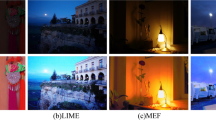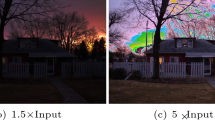Abstract
Low-light images often suffer from noise and color distortion. Object detection, semantic segmentation, instance segmentation, and other tasks are challenging when working with low-light images because of image noise and chromatic aberration. We also found that the conventional Retinex theory loses information in adjusting the image for low-light tasks. In response to the aforementioned problem, this paper proposes an algorithm for low illumination enhancement. The proposed method, KinD-LCE, uses a light curve estimation module to enhance the illumination map in the Retinex decomposed image, improving the overall image brightness. An illumination map and reflection map fusion module were also proposed to restore the image details and reduce detail loss. Additionally, a TV(total variation) loss function was applied to eliminate noise. Our method was trained on the GladNet dataset, known for its diverse collection of low-light images, tested against the Low-Light dataset, and evaluated using the ExDark dataset for downstream tasks, demonstrating competitive performance with a PSNR of 19.7216 and SSIM of 0.8213.







Similar content being viewed by others
Availability of data and materials
The data that support the findings of this study are available on request from thecorresponding author, Jiang, upon reasonable request.
References
Pizer, S.M. et al.: Adaptive histogram equalization and its variations. Comput. Vision, Gr., Image Process 39.3 (1987).
Land, E.H. and McCann, J.J.: Lightness and retinex theory. Josa 61.1, (1971).
Zhou, J., Zhang, D., Zhang, W.: Multiscale fusion method for the enhancement of low-light underwater images. Math. Probl. Eng. 2020, 1–15 (2020)
Jobson, D.J., Rahman, Z.-u, Woodell, G.A.: A multiscale retinex for bridging the gap between color images and the human observation of scenes. IEEE Trans. Image Process. 6(7), 965–976 (1997)
Liu, R. et al. Retinex-inspired unrolling with cooperative prior architecture search for low-light image enhancement. Proceedings of the IEEE/CVF Conference on Computer Vision and Pattern Recognition. (2021).
Yan, M., Lou, X., Chan, C.A., Wang, Y., Jiang, W.: A semantic and emotion-basedlatent variable generation model for a dialogue system. CAAI Trans. Intell. Technol. 2023, 1–12 (2023). https://doi.org/10.1049/cit2.12153
Guo, C., et al.: Zero-reference deep curve estimation for low-light image enhancement. Proceedings of the IEEE/CVF Conference on Computer Vision and Pattern Recognition. (2020).
Rahman, Z., et al.: Efficient image enhancement model for correcting uneven illumination images. IEEE Access 8, 109038–109053 (2020)
Li, C. et al.: Learning to enhance low-light image via zero-reference deep curve estimation" IEEE Transactions on Pattern Analysis and Machine Intelligence. (2021)
Zhang, Y., Zhang, J. and Guo, X.: Kindling the darkness: a practical low-light image enhancer." Proceedings of the 27th ACM International Conference on Multimedia. (2019).
Zhang, Y. et al.: Beyond brightening low-light images. Int. J. Comput. Vision 129.4 (2021).
Jiang, Y., et al.: EnlightenGAN: deep light enhancement without paired supervision. IEEE Transact. Image Process. 30, 2340–2349 (2021)
**e, J., et al.: Semantically-guided low-light image enhancement. Pattern Recognit. Lett. 138, 308–314 (2020)
Guan, Y., et al.: A dual-tree complex wavelet transform-based model for low-illumination image enhancement. Wuhan Univ. J. Nat. Sci. 26.05, 405–414 (2021)
Rahman, Z., et al.: "Structure revealing of low-light images using wavelet transform based on fractional-order denoising and multiscale decomposition. Vis. Comput. 375, 865–880 (2021)
Liu, Y. et al.: Image fusion with convolutional sparse representation. IEEE Signal Process. Lett. 23.12 (2016).
Yan, M., Chan, C.A., Li, W., Chih-Lin, L., Bian, S., Gygax, A.F., Leckie, C., Hinton, K., Wong, E., Nirmalathas, A.: Network energy consumption assessment of conventional mobile services and over-the-top instant messaging applications. IEEE J. Sel. Areas Commun. 34(12), 3168–3180 (2016)
Yan, M., Li, W., Chan, C.A., Bian, S., Chih-Lin, I., Gygax, A.F.: "PECS: towards personalized edge caching for future service-centric networks. China Commun. 16(8), 93–106 (2019)
Ying, Z. Li, G. and Gao, W.: A bio-inspired multi-exposure fusion framework for low-light image enhancement. ar**v preprint ar**v:1711.00591 (2017).
Ying, Z. et al.: A new image contrast enhancement algorithm using exposure fusion framework. International Conference on Computer Analysis of Images and Patterns. Springer, Cham, (2017).
Gharbi, M. et al.: Deep bilateral learning for real-time image enhancement. ACM Transact. Gr. (TOG), 36.4, (2017).
Li, C. et al.: Low-light image and video enhancement using deep learning: a survey. IEEE Transactions on Pattern Analysis & Machine Intelligence, 01, (2021).
Guo, X., Li, Y. and Ling, H.: LIME: low-light image enhancement via illumination map estimation. IEEE Transact. Image Process. 26.2 (2016).
Lore, K.G., Akintayo, A. and Sarkar, S. LLNet: a deep autoencoder approach to natural low-light image enhancement. Pattern Recog. 61 (2017).
Rudin, Leonid I., Stanley Osher, and Emad Fatemi. "Nonlinear total variation based noise removal algorithms." Physica D: nonlinear phenomena 60.1–4 (1992).
Wei, C. et al.: Deep retinex decomposition for low-light enhancement. ar**v preprint ar**v:1808.04560 (2018).
Wang, W. et al.: Gladnet: Low-light enhancement network with global awareness. 2018 13th IEEE International Conference on Automatic Face & Gesture Recognition (FG 2018). IEEE, (2018).
Loh, Y.P., Chan, C.S.: Getting to know low-light images with the exclusively dark dataset. Comput. Vis. Image Underst. 178, 30–42 (2019)
Huynh-Thu, Q., Ghanbari, M.: Scope of validity of PSNR in image/video quality assessment. Electron. Lett. 44(13), 800–801 (2008)
Wang, Z., et al.: Image quality assessment: from error visibility to structural similarity. IEEE Transact Image Process. 134, 600–612 (2004)
Lv, F. et al.: MBLLEN: low-light image/video enhancement using CNNs. BMVC. 220(1) (2018).
Yuan, Y., Chen, X., Wang, J.: Object-contextual representations for semantic segmentation. European conference on computer vision. Springer, Cham (2020)
Cordts, M. et al.: The cityscapes dataset for semantic urban scene understanding. Proceedings of the IEEE conference on computer vision and pattern recognition. 2016.
Funding
This work was supported by the National Natural Science Foundation of China (61876049, 62172118) and Nature Science key Foundation of Guangxi (2021GXNSFDA196002); in part by the Sichuan Regional Innovation Cooperation Project (2021YFQ0002); in part by the Guangxi Key Laboratory of Image and Graphic Intelligent Processing under Grants (GIIP2004) and Student’s Platform for Innovation and Entrepreneurship Training Program under Grant (202010595053, 202010595168, S202110595168, 202110595025, 202310595036).
Author information
Authors and Affiliations
Contributions
XL. and JX. contributed to Conceptualization; JX and WM contributed to Data Curation; XL and JX contributed to Formal Analysis; JX and XL contributed to Methodology; ZJ and ZG contributed to Supervision; ZS and LL contributed to Validation; LL and CL, ZG and WM contributed to Visualization; XL and JX contributed to Writing original draft preparation, ; ZJ, ZG and WM contributed to Writing review and editing; All authors have read and agreed to the published version of the manuscript.
Corresponding author
Ethics declarations
Conflict of interest
No potential conflict of interest was reported by the authors.
Ethical approval
This declaration is “not applicable”.
Additional information
Publisher's Note
Springer Nature remains neutral with regard to jurisdictional claims in published maps and institutional affiliations.
Rights and permissions
Springer Nature or its licensor (e.g. a society or other partner) holds exclusive rights to this article under a publishing agreement with the author(s) or other rightsholder(s); author self-archiving of the accepted manuscript version of this article is solely governed by the terms of such publishing agreement and applicable law.
About this article
Cite this article
Lei, X., Mai, W., **e, J. et al. KinD-LCE: curve estimation and Retinex Fusion on low-light image. SIViP 18, 1733–1746 (2024). https://doi.org/10.1007/s11760-023-02850-2
Received:
Revised:
Accepted:
Published:
Issue Date:
DOI: https://doi.org/10.1007/s11760-023-02850-2




